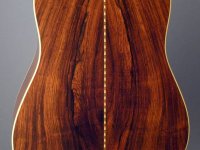I Thought I'd ask the question more directly in the Thread Title so no one has to read below. This is the first time I've tried such a major edit on a thread. If you have a few ukuleles, is your favorite sounding one today, knowing it could change tomorrow, the one with a very straight, tight grain?
EVERYTHING ELSE BEING EQUAL ...
I'm still under the impression that a nice, tight, straight grain on a ukulele going the same direction as the strings gives the best sound. Am I wrong?
Do Mango and Cocobolo ukulele builders not care about quarter sawn boards? I understand why some folks might like the wilder visual patterns (kind of like some flat sawn oak planks on my floor), but I'm still under the impression that a nice, tight, straight grain going the same direction as the strings gives the best sound. Am I wrong?
I'm not trying to open a can or worms here. I'm simply curious if my impression over the years is wrong. If anyone with a few ukuleles can tell me that their favorite is something other than a quarter sawn (or at least looks quarter sawn) top, please let me know. Thanks
EVERYTHING ELSE BEING EQUAL ...
I'm still under the impression that a nice, tight, straight grain on a ukulele going the same direction as the strings gives the best sound. Am I wrong?
Do Mango and Cocobolo ukulele builders not care about quarter sawn boards? I understand why some folks might like the wilder visual patterns (kind of like some flat sawn oak planks on my floor), but I'm still under the impression that a nice, tight, straight grain going the same direction as the strings gives the best sound. Am I wrong?
I'm not trying to open a can or worms here. I'm simply curious if my impression over the years is wrong. If anyone with a few ukuleles can tell me that their favorite is something other than a quarter sawn (or at least looks quarter sawn) top, please let me know. Thanks
Last edited:


